Just for fUN
/
�
�
or
THE STORY OF AN ACCIDENTAL REVOLUTIONARY
LINUS TORVALDS,
CREATOR OF LINUX,
AND DAVID DIAMOND
�
JUST FOR FUN. Copyright @ 2001 by LinusTort/aids andDavidDiamond.
All rights reserved. Printed in theUnited States ofAmerica. Nopart ofthisbook
maybe used orreprodmed in any manner whatsoever without written permission
except in thecase ofbriefquotations emhodied in ",i1ical articles and reviews.
For information, address HarperCo//ins Publishers, lnc., 10 East53rdStreet,
New York, NY 10022.
HarperCo//ins books maybepurrhasedforeducational, business, orsales
promotional use. Forinformation please write: Special Markets Department,
HarptrCo//ins Publishers, lnc., 10 East53rd Street, New York, NY 10022.
FIRST EDITION
Designed by Fritz Metsch
"IstheLinux Revolution Over" beginning onpage 186 is reprintedfrom ZD Net,
August26, 1999, withpermission. Copyright © 1999, ZD Na lnc.
All rights reserved.
Library ofCongress Cataloging-in-Publkation Data
Tort/aids, Linus, 1969-
Just forfun : thestory ofan a«idenral revolutionary I LinusTort/aids and
DavidDiamond.
p.
ISBN 0-06-662072-4 (he)
1. Tort/aids, Linus, 1969- 2. Computerprogrammers-Finland-Biography.
3. Linux.l. Diamond, David. II. Tille.
em.
QA76.2.T67 T67 2001
005.1'092~21
fB}
01
02
03
04 05 QW 10
9 8
7 6 5
4 3
2
1
00-054199
�
To Tove and Patricia, Daniela, and Celeste. I always wanted to be
surrounded byyoung women, and you made it so.
To Tia and Kaley. Boy do I fee! blessed.
This wouldn't qualifyas acknowledgments without thedropping ofsome
important names, so here goes:
we acknowledge our editor, Adrian Zackheim, who caved in to our every
demand; Erin Richnow, theHarperCollins assistant editor who was more
on top ofthisproject than wewere; our agents, Bill Gladstone of Water
side Productions and Kris Dah! ofICM, who couldn't have been speedier
in the forwarding ofour checks to us; Sara Torvalds, who hasthe best
backup memory on theFennoscandia peninsula-and operates in three
languages-and William and Ruth Diamond, who read theoriginal
manuscript and kept repeating, "N,0, really, it'sgood. "
�
My heartwas in mythroat when he was growing up: How on Earthwas
he going to meet any nice girls that way?
-Anna Torvalds
�
Introduction:
Post-Its from a Revolution
Duringthe euphoria ofthefinal years ofthetwentieth century, a
revolution washappening among all theother revolutions. Seemingly
overnight, the Linux operating system caught theworld's attention. It had
explodedfrom thesmallbedroom of its creator, LinusTorvalds, toattract
a cultish following of near-militant geeks. Suddenly it was infiltrating
thecorporate powerhouses controlling theplanet. From a party ofone it
now counted millions ofusers on every continent, including Antarctica,
and even outer space, ifyou count NASA outposts. Not only wasit the
most common operating system running server computers dishing outall the
content on theWorld Wide W'eb, but its very development model-an
intricate web ofits own, encompassing hundreds ofthousands ofvolunteer
computer programmers-had grown to become thelargest collaborative
project in thehistory of theworld. The open source philosophy behind it all
was simple: Information, in this case thesource code orbasic instructions
behind theoperating system, should be free andfreely sharedfor anyone
interested in improving upon it. But those improvements should also be
freely shared. Thesame concept hadsupported centuries ofscientific discov
ery. Now it wasfinding a home in thecorporate sphere, and it waspossi
ble to imagine itspotential as a framework for creating thebest of
anything: a legal strategy, an opera.
Some folks caught a glimpse of thefuture and didn'tlike what
they saw. Linus's round, bespectacled countenance became a favored dart
board target within Microsoft Corporation, which wasnow faced with its
first honest-to-goodness competitive threat. But, more often, people wanted
to learn more about the kid who--ifhedid notstartit all-at least
ix
�
jump-started it and was, in effect, its leader. The trouble was, themore
successful Linu» and open source became, theless hewanted to talk about
it. Theaccidental revolutionary started Linux because playingon a com
puter wasfun (andalso because thealternatives weren't that attractive).
So when someone triedtoconvince him tospeak at a major event bytelling
him that his millions offollowers just wanted toat least see him, in the
flesh, Linusgood-naturedly offered toparticipate in a dunk-tank instead.
That wouldbe more fun, heexplained. And a way of raising money.
They declined. It wasn't their idea ofhowto rnna revolution.
Revolutionaries aren't born. Revolutions can't be planned. Revolu
tions can't be managed.
Revolutions happen....
-David Diamond
x
just for Fun
�


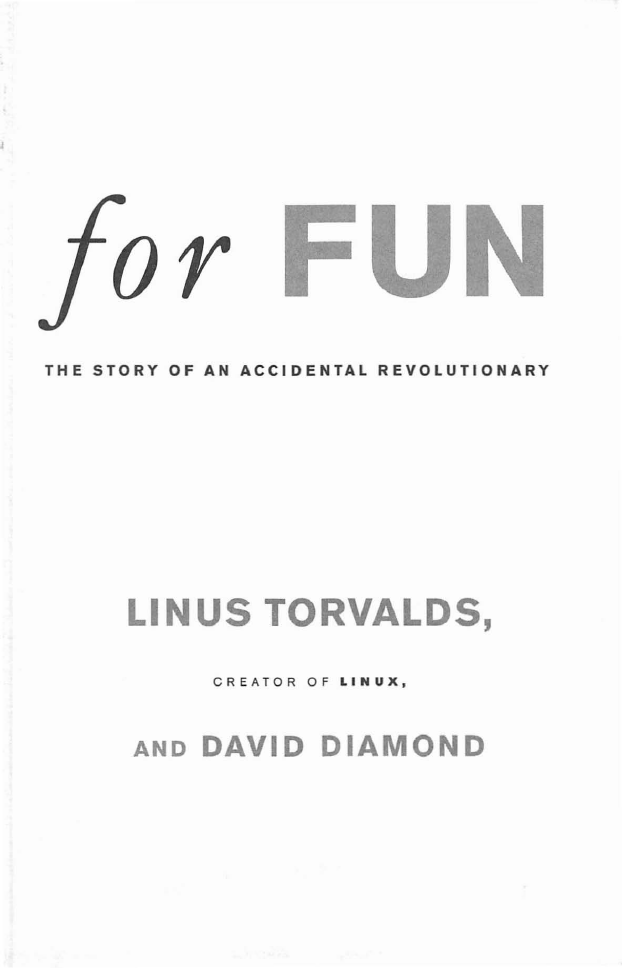
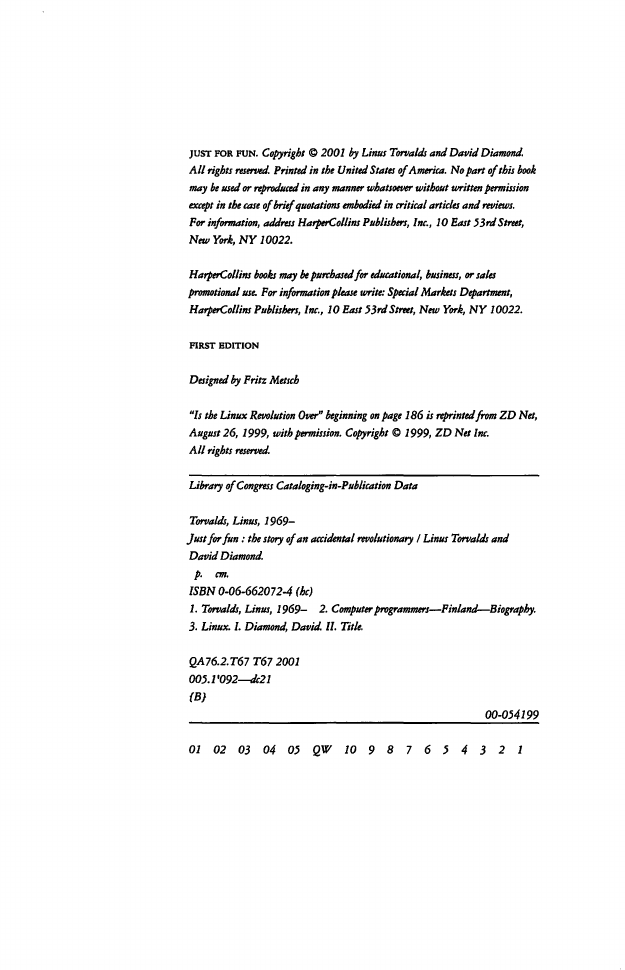
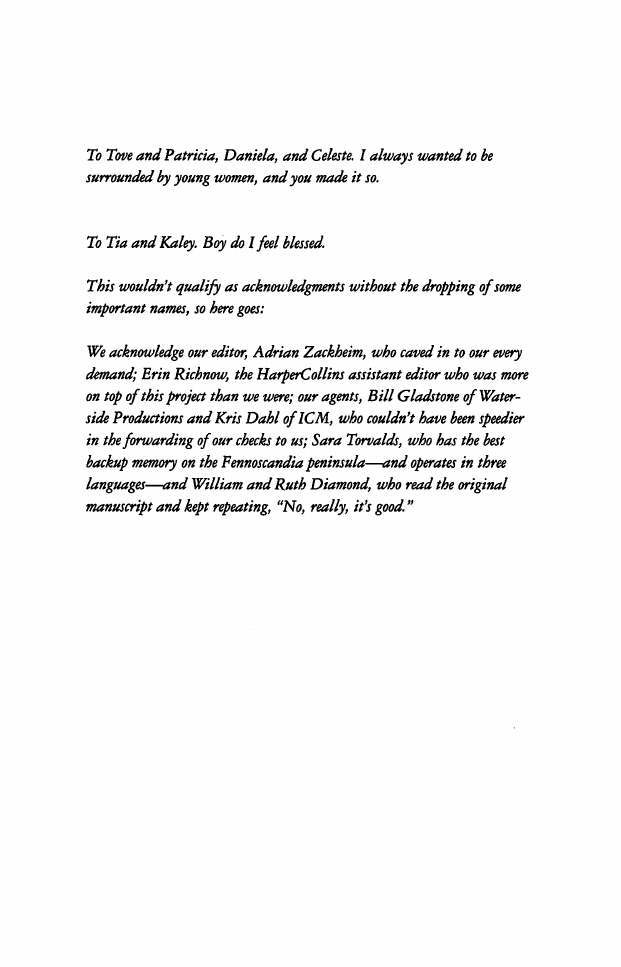

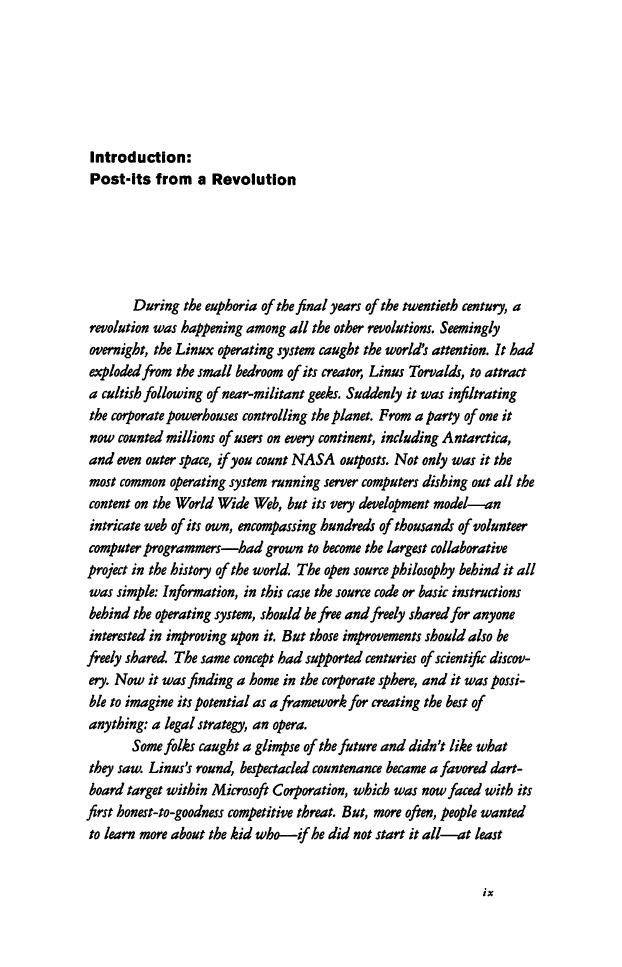
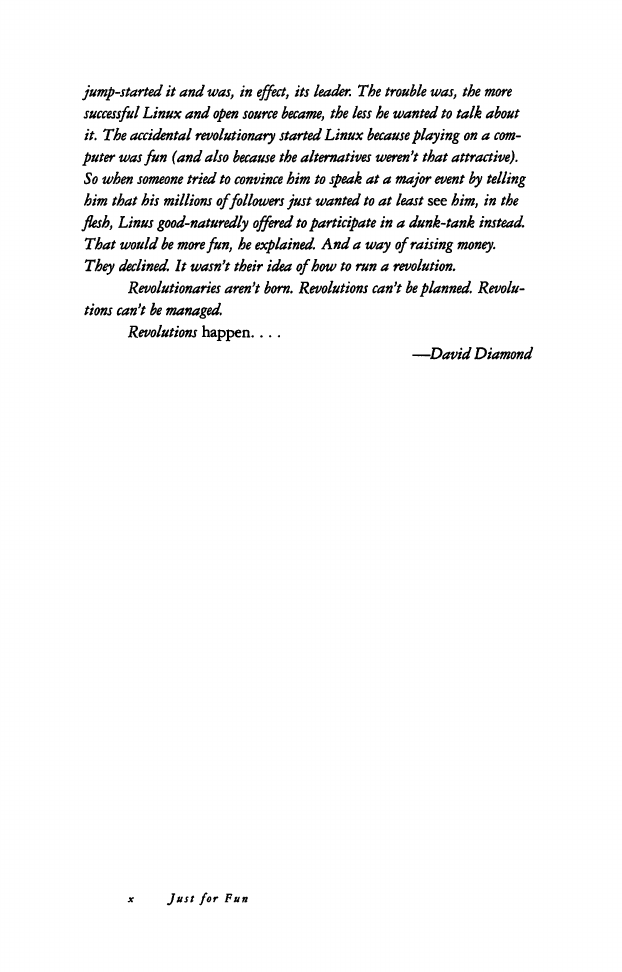








 2023年江西萍乡中考道德与法治真题及答案.doc
2023年江西萍乡中考道德与法治真题及答案.doc 2012年重庆南川中考生物真题及答案.doc
2012年重庆南川中考生物真题及答案.doc 2013年江西师范大学地理学综合及文艺理论基础考研真题.doc
2013年江西师范大学地理学综合及文艺理论基础考研真题.doc 2020年四川甘孜小升初语文真题及答案I卷.doc
2020年四川甘孜小升初语文真题及答案I卷.doc 2020年注册岩土工程师专业基础考试真题及答案.doc
2020年注册岩土工程师专业基础考试真题及答案.doc 2023-2024学年福建省厦门市九年级上学期数学月考试题及答案.doc
2023-2024学年福建省厦门市九年级上学期数学月考试题及答案.doc 2021-2022学年辽宁省沈阳市大东区九年级上学期语文期末试题及答案.doc
2021-2022学年辽宁省沈阳市大东区九年级上学期语文期末试题及答案.doc 2022-2023学年北京东城区初三第一学期物理期末试卷及答案.doc
2022-2023学年北京东城区初三第一学期物理期末试卷及答案.doc 2018上半年江西教师资格初中地理学科知识与教学能力真题及答案.doc
2018上半年江西教师资格初中地理学科知识与教学能力真题及答案.doc 2012年河北国家公务员申论考试真题及答案-省级.doc
2012年河北国家公务员申论考试真题及答案-省级.doc 2020-2021学年江苏省扬州市江都区邵樊片九年级上学期数学第一次质量检测试题及答案.doc
2020-2021学年江苏省扬州市江都区邵樊片九年级上学期数学第一次质量检测试题及答案.doc 2022下半年黑龙江教师资格证中学综合素质真题及答案.doc
2022下半年黑龙江教师资格证中学综合素质真题及答案.doc